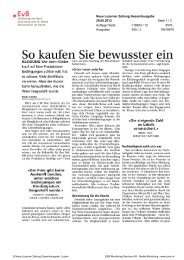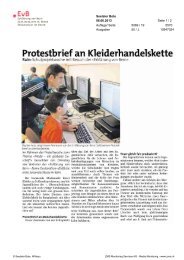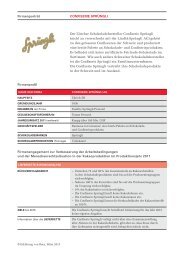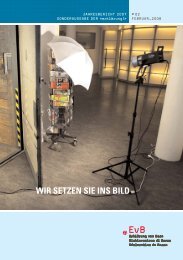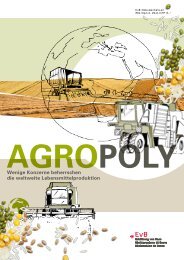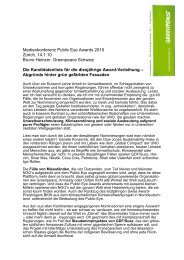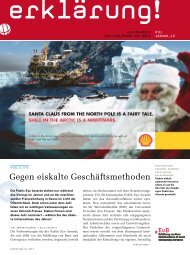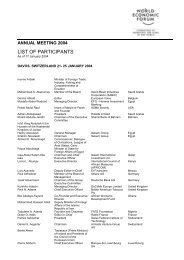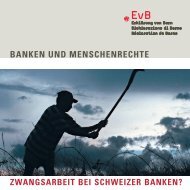Maid in India
Maid in India
Maid in India
You also want an ePaper? Increase the reach of your titles
YUMPU automatically turns print PDFs into web optimized ePapers that Google loves.
<strong>Maid</strong> <strong>in</strong> <strong>India</strong><br />
2. Labour practices <strong>in</strong> the Tamil Nadu textile<br />
and garment <strong>in</strong>dustry<br />
The textile and garment <strong>in</strong>dustry is of vital importance to the <strong>India</strong>n economy. It is a large provider<br />
of foreign currency and it is a source of employment, generat<strong>in</strong>g work for more than 35 million<br />
people. After Ch<strong>in</strong>a 6 , <strong>India</strong> is the largest exporter of textile yarn. When it comes to exports of<br />
apparel items, <strong>India</strong> holds third place, after Ch<strong>in</strong>a and Bangladesh. 7<br />
<strong>India</strong> is a producer of natural raw materials such as cotton, jute, silk and wool. Synthetic fibres are<br />
also produced <strong>in</strong> <strong>India</strong>, but the <strong>India</strong>n garment <strong>in</strong>dustry is predom<strong>in</strong>antly cotton based. Major export<br />
dest<strong>in</strong>ations are Europe and the United States.<br />
2.1. The cotton garment supply cha<strong>in</strong><br />
Over the last decades, large retailers and brand companies have played pivotal roles <strong>in</strong> sett<strong>in</strong>g up<br />
decentralised production networks <strong>in</strong> a variety of export<strong>in</strong>g countries. Typically, most export<br />
countries are develop<strong>in</strong>g countries. Brands and retailers set the terms for contractors that make the<br />
f<strong>in</strong>ished goods. The brands and retailers generally do the design<strong>in</strong>g, brand<strong>in</strong>g and market<strong>in</strong>g but<br />
they do not make the products they sell. Profits come from comb<strong>in</strong>ations of high-value research,<br />
design, sales, market<strong>in</strong>g and f<strong>in</strong>ancial services that allow the retailers, designers and marketers to<br />
act as strategic brokers <strong>in</strong> l<strong>in</strong>k<strong>in</strong>g overseas factories and traders with product niches <strong>in</strong> their ma<strong>in</strong><br />
consumer markets. 8<br />
The sales part of the value cha<strong>in</strong> is characterised by high entry barriers for new brand companies<br />
and retailers. Entry barriers for manufacturers, by contrast, are low. The relative ease of sett<strong>in</strong>g up<br />
manufactur<strong>in</strong>g companies has led to an unparalleled diversity of garment exporters <strong>in</strong> develop<strong>in</strong>g<br />
countries who are fac<strong>in</strong>g immense competition and low returns. 9 This contributes to power<br />
imbalances between the retailers/brands and manufacturers.<br />
Retailers and brand companies concentrate on sell<strong>in</strong>g garments while transferr<strong>in</strong>g, as much as<br />
possible, the rest of the production activities to their manufactur<strong>in</strong>g suppliers. It is <strong>in</strong> the <strong>in</strong>terest of<br />
the suppliers to offer a ‘full package’ service, <strong>in</strong>clud<strong>in</strong>g upstream and downstream activities.<br />
Upstream, mean<strong>in</strong>g tak<strong>in</strong>g responsibility for sourc<strong>in</strong>g fabric and trim. Downstream, mean<strong>in</strong>g<br />
organis<strong>in</strong>g the logistics and transportation, and deliver<strong>in</strong>g the items to the retailer’s warehouse or<br />
even stores <strong>in</strong> a ‘ready-for-sale’ packaged state. 10<br />
6<br />
7<br />
8<br />
9<br />
10<br />
Includ<strong>in</strong>g Hong Kong.<br />
Based on data from: United Nations Conference on Trade and Development, ‘UNCTAD Handbook of Statistics 2011’,<br />
United Nations, New York and Geneva, 2011.<br />
Based on McCormick, D. (2001), Gereffi, G. et al. (2003) The Global Apparel Value Cha<strong>in</strong>: What Prospects for<br />
Upgrad<strong>in</strong>g by Develop<strong>in</strong>g Countries? UNIDO: Vienna and Pan, J. (2008) Global Cotton and Textile Product Cha<strong>in</strong>s:<br />
Identify<strong>in</strong>g challenges and opportunities for Ch<strong>in</strong>a through a global commodity cha<strong>in</strong> susta<strong>in</strong>ability analysis. International<br />
Institute for Susta<strong>in</strong>able Development (IISD): Manitoba; Devaraja, T.S., <strong>India</strong>n Textile and Garment Industry – An<br />
Overview (Hassan, <strong>India</strong>: University of Mysore, May 2011).<br />
Ibid.<br />
The International Bank for Reconstruction and Development, 2008.<br />
14



